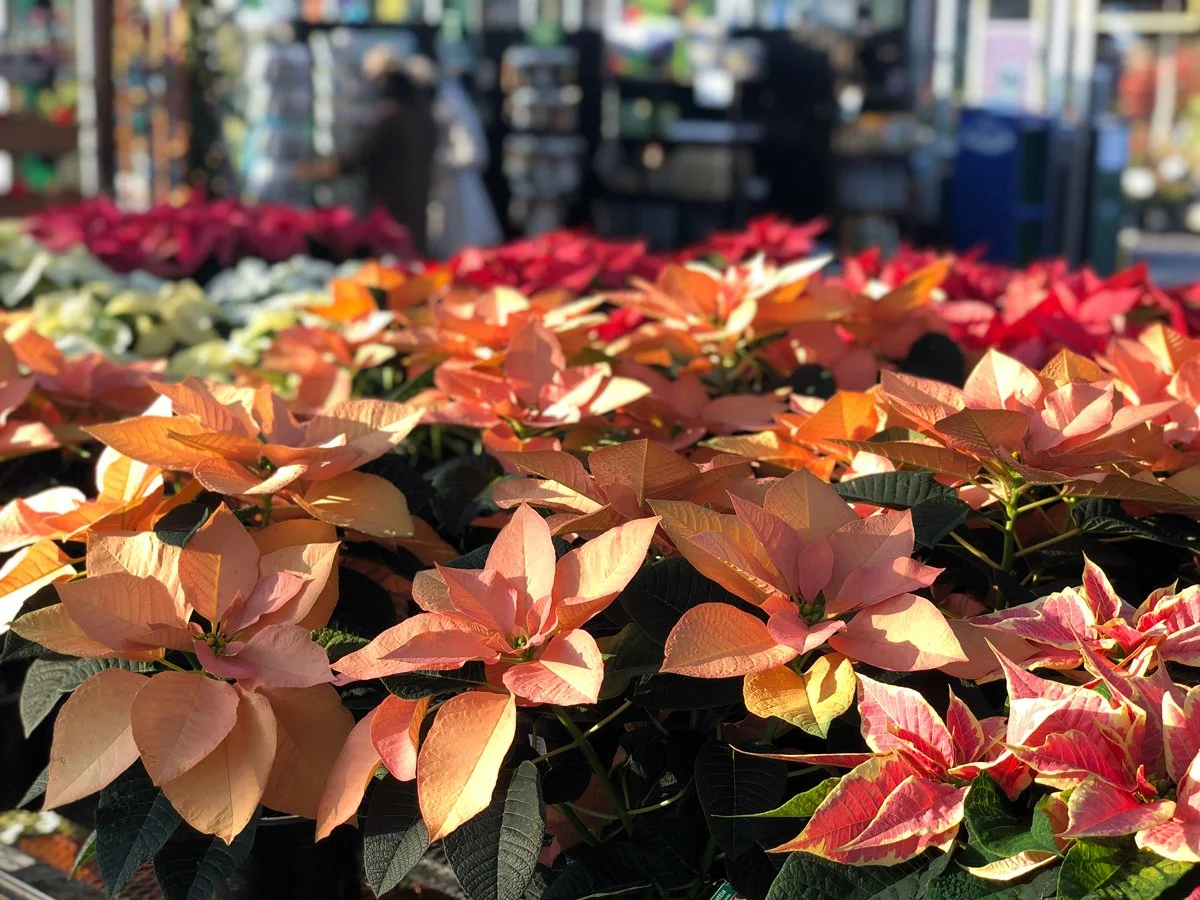With cheerful red bracts and delicate yellow flowers framed against velvety green leaves, colorful poinsettias are an indisputable symbol of Christmas. In fact, poinsettias are the most commercially important potted plant in the world because of their endearing association with the December holiday season. But how did this warm-weather shrub native to western Mexico become so closely associated with Christmas?
The original Nahuatl name for the plant we call “poinsettia” is cuetlaxochitl (kwet-la-sho-she), cultivated by the Aztecs long before the European colonization of the Americas. The Aztecs used cuetlaxochitl for a variety of purposes, including decoration and the production of red and purple dyes, as well as for medicines derived from the plant’s milky white sap.
Responding to the lengthening nights after the autumn equinox, wild cuetlaxochitl in western Mexico come into full bloom by the month of December. Green leaves give way to red, pink, or white bracts that surround the small yellow flowers on the end of the plants’ tall stems. A bract is a modified leaf associated with a plant’s flowers; in the case of cuetlaxochitl, the brightly colored bracts help attract pollinators to the small flowers. To ensure blooms, cuetlaxochitl need extended periods of darkness (14-16 hours per night) beginning in late September, which can be accomplished indoors by moving the plant to a dark room or covering it completely with a cloth or box. Cuetlaxochitl also need warmth to survive, requiring temperatures between 60-70 degrees Fahrenheit like its tropical native range.
The timing of the annual bloom for wild cuetlaxochitl began the plant’s association with the Christmas season during the 16th century, when missionaries spread the Catholic faith through the indigenous communities of Mexico. In the southwestern Mexican city of Taxco, Franciscan friars used the plant to decorate Nativity scenes. Local legend tells of a young poor girl named Pepita, who was on her way to church on Christmas Eve. Realizing she had forgotten an offering, Pepita gathered a humble bouquet of roadside weeds as a gift for the newborn Jesus. When Pepita placed the bouquet at the base of the altar, the weeds burst into the colorful blooms of the cuetlaxochitl. The plant subsequently came to be called la flor de Nochebuena, literally “the Christmas Eve flower,” or simply “the Christmas flower.”
In 1828, cuetlaxochitl was taken from its native home and brought to the United States by Joel Roberts Poinsett, the U.S. Ambassador to Mexico. After successfully cultivating the unique plant in his South Carolina greenhouse, Poinsett began sharing the plant with friends and colleagues who marveled at the plant’s colorful transformation during the holiday season. A nursery owner in Pennsylvania named Robert Buist was the first to sell the plant to the public under its botanical name, Euphorbia pulcherrima. However, less than a decade after being introduced to the United States, cuetlaxochitl came to be known by its most enduring name: poinsettia, after the man who first appropriated the plant from Mexico. Poinsett is celebrated for introducing the poinsettia to the United States and for co-founding the Smithsonian Institution. However, his legacy as a slave owner and his role in the displacement of countless Native Americans has led some people today to reject the name “poinsettia” in favor of the plant’s Native name, cuetlaxochitl.
In the early 1900s, the poinsettia plant boomed in popularity in the United States, becoming an economic and cultural force during the Christmas season. Developing a method to cultivate the plants indoors in mass quantities, Paul Ecke Sr. founded the Ecke Ranch in Encinitas, California in 1923. The Ecke family worked tirelessly to promote the poinsettia as a Christmas symbol, and their business model proved lucrative. Today, around 70% of all commercially grown poinsettia plants in the United States originate from Ecke Ranch.
In the mid-1990s, American plant pathologist Ing-Ming Lee of the United States Department of Agriculture determined that a phytoplasma infection of poinsettias resulted in more compact plants with a greater number of flowers, contrasting the lanky appearance of wild cuetlaxochitl. Phytoplasmas are a type of bacteria that affect the growth pattern of infected plants. While growers like the Ecke family had long utilized special grafting techniques to produce compact plants, the widespread commercial adaptation of Lee’s method literally shaped the poinsettia plants we see today in homes, churches, and greenhouses across the world. In 2002, the United States Congress designated December 12 as “National Poinsettia Day,” acknowledging both the economic importance of the plant and the close cultural ties between the United States and Mexico.
With many names stemming from its complex history, cuetlaxochitl has long captured the human imagination with its magnificent seasonal transformation. Understanding the difficult aspects of the plant’s past does not dim its beauty—rather, it helps us reflect upon our own multicultural legacy. Whether you call it a poinsettia, la flor de Nochebuena, cuetlaxochitl, or something else, this attractive plant is a must-have floral feature during the holiday season.
Learn how to care for your plant here.




